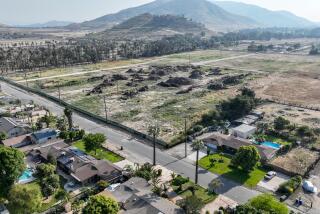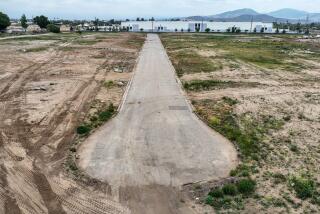Group rallies to rescue town’s icon: a garage
Ten years ago Virginia Geil lost her heart -- to a garage.
Not just any garage -- a corrugated metal monster of a garage. A garage so big it could swallow two other garages, an echoing steel cavern crammed with engines, pumps and a boxy, blue milk truck built like a tank.
But the 94-year-old relic that dispensed gas, oil and comfort food to travelers heading to Palm Springs had a date with a bulldozer. Progress had come calling, and the Bloomington Garage, shuttered since 1968, would give way to a modern mini-mart peddling foil-wrapped hot dogs and microwave burritos, oil in plastic jugs and gas from computerized pumps.
“It was 1996 and I heard them say the garage was coming down,” recalled Mark Hoover. “It made Bloomington Bloomington. It was an icon. I ran home and told grandma because she always had an understanding of history. She looked at me and said, ‘What shall we do?’ ”
And so it began.
Armed with a steely resolve behind a grandmother’s sweet smile, Geil -- now 83 -- launched a decadelong, quixotic effort to salvage one of the last bits of Bloomington’s rapidly fading history.
Once a rural idyll of citrus trees, onion fields and boysenberries, Bloomington has become a congested, gritty slice of Inland Empire sandwiched between Fontana and Rialto. Interstate 10 cuts the unincorporated community in half. Over the years it has withered from 29 square miles to just six, with a population of about 20,000. Now Fontana is trying to annex a big chunk of what’s left while Bloomington has countered with a bid for cityhood.
If it fails, many believe, the hamlet will ultimately disappear.
“When the garage was built in 1912 there was nothing here but pasture. You came down this valley and the garage was the center of town,” Geil said. “When they went through with the freeway it took the heart out of Bloomington.”
Restoring the garage, she hopes, will restore a bit of that heart.
Originally from Oklahoma, Geil wired B-29 bombers during World War II, ran a restaurant near Chino Hills and was a butcher in Cudahy.
Retired with six grandchildren and eight great-grandkids, she hadn’t banked on spending her golden years saving an antiquated filling station.
“I was the only one who didn’t work, so I had the time,” she said.
Geil formed the Bloomington Preservation Foundation and decided to move the garage from the corner of Cedar Avenue and Valley Boulevard down the road. In 1997, after months of fundraising, grant-writing and $40,000 of her own money, the garage was hoisted onto a specialized vehicle and very, very slowly driven away. Four hundred people showed up to watch.
“We started moving it at 2 a.m. and it took seven or eight hours to move it three blocks,” Geil said.
Then officials of a billboard company claimed that it blocked their signs and demanded that it be moved again.
So the garage was inched across the road to a spot near Interstate 10 where it is easily visible to passing motorists.
Since then, the 80-foot-long green and white behemoth has been gradually refurbished. Volunteers descend every weekend, including youths performing community service, trying to transform it from brooding hulk to living museum.
“The kids have been no trouble and I’m so proud of them,” Geil said, clasping her hands in front of her. “One made me the godmother of their baby.”
Many volunteers are senior citizens, which has its own perils. On a recent day, four were out. One was awaiting a liver transplant, one a kidney transplant, another was recovering from a heart attack, and a fourth was suffering from side effects of Parkinson’s disease.
Geil was as chirpy and spry as ever.
“I don’t think this has taken a toll on her,” said grandson Hoover, 30. “In fact, I think it keeps her alive.”
Geil’s eyes twinkled as she described her vision for “The Bloomington Old Town Plaza,” consisting largely of the garage.
She glided across the floor, pointing out an engine, an egg incubator, a drill press, a glass oil bottle, a few old signs.
“This will be a solid wall of pictures,” she said of a spot near the door. “You’ll push a button and one of the guys will tell us what each thing is. It will be a living museum. I want the kids to see this. They’ll get a lot more out of it than they would from books.”
Attached to the garage is the 1913 home of the former garage owner, the late Dan Lague. Geil has plans for that too.
She ascended the staircase.
“See, it’s going to be a wedding chapel. The bride will come down these steps with her dad and we’ll have a camera built in here to take a picture,” she explained.
Many who help Geil are car club members and that rare breed of antique lover, the vintage garage aficionado.
“We save our old aircraft and automobiles, but our garages they want to bulldoze,” said 65-year-old George Forget of Yucaipa. “They don’t seem to think the structures themselves are worth saving, but you don’t find many buildings like these left.”
Ed Powely, 65, of Bloomington claims to have the biggest unofficial junkyard in town. He once tried to buy two old gas stations himself.
“I wanted to put them in my backyard but they bulldozed the things before I could get to them,” he said.
For many, the garage represents a different era, when Bloomington was more Mayberry than the edgier place it has become.
“I want Bloomington to be known for more than used car lots and street vendors,” said volunteer Patricia Rueff, 69. “When this was a rural place it was a more meaningful way of life.”
Geil hopes to finish work within a year. The chief obstacle is shoring up a back wall in case of an earthquake. She’ll need an engineer and some money, and so far the business plan is a bit shaky.
“I’m going to plant a money tree and watch it grow,” she quipped.
Then Geil grew serious, rolled out some sketches for the wall and peered intently at a visitor.
“I need an engineer to read the plans and sign off on them,” she said. “Everything is exactly correct. I just need a signature. Can you find me an engineer? Do you want to sign?”
*
More to Read
Sign up for Essential California
The most important California stories and recommendations in your inbox every morning.
You may occasionally receive promotional content from the Los Angeles Times.










